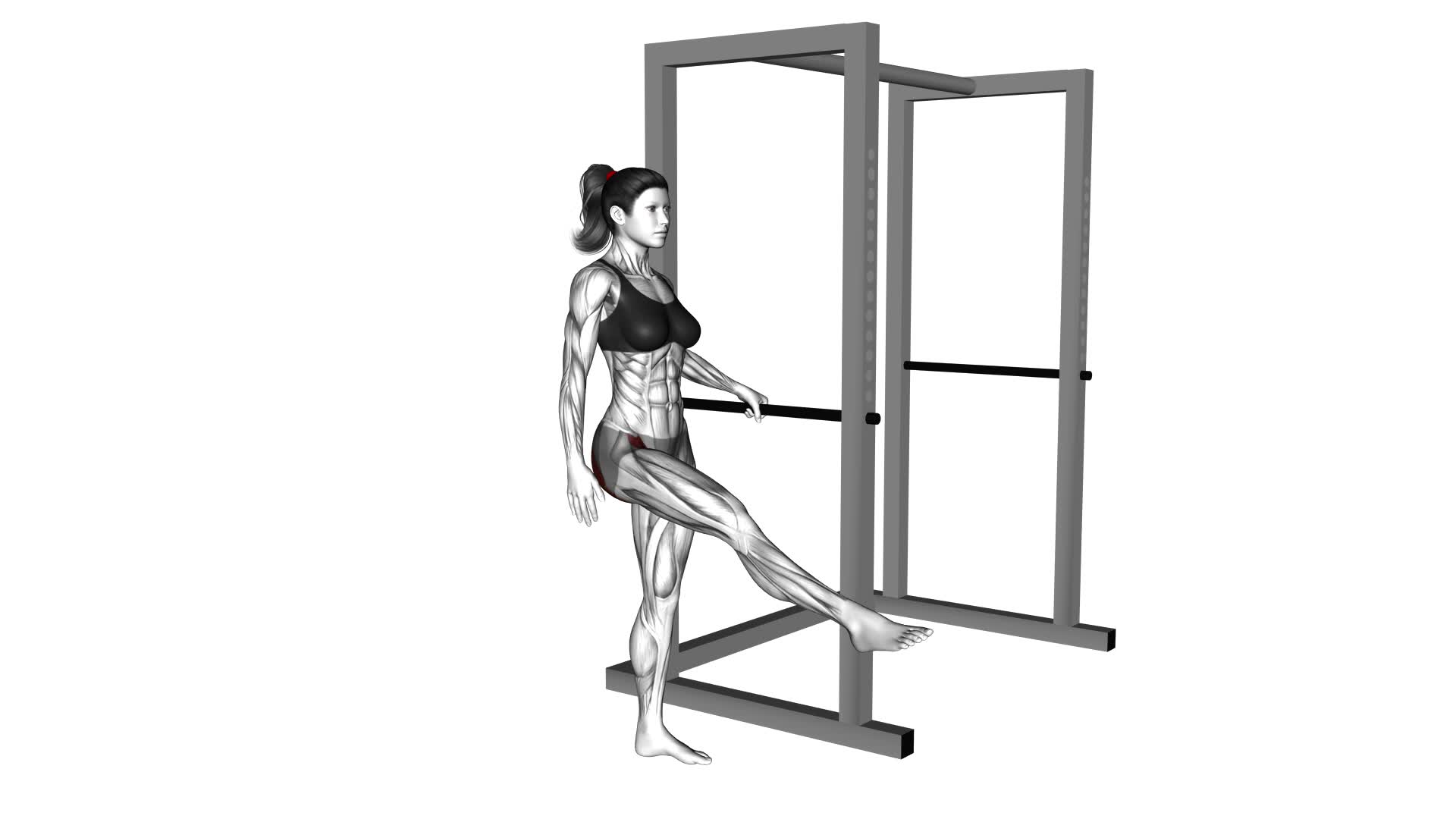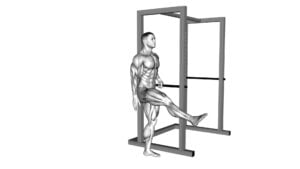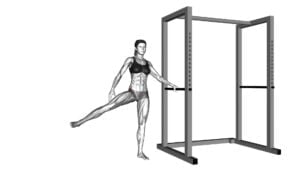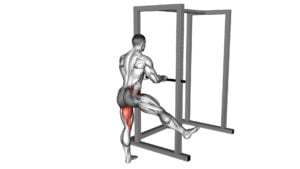Back Forward Leg Swings (female) – Video Exercise Guide & Tips

Looking to tone and strengthen your legs? Look no further than back forward leg swings!
Watch This Exercise Video
This video exercise guide is here to help you perfect your form and technique. With variations to add challenge and tips to avoid common mistakes, you'll be maximizing your results in no time.
Get ready to feel the burn and achieve those leg goals with this informative and precise workout.
Let's get started!
Key Takeaways
- Back forward leg swings improve flexibility and range of motion.
- They target muscles in the hips, hamstrings, and quadriceps.
- Leg swings help prevent injuries during quick movements or changes in direction.
- They enhance overall athletic performance and lower body mobility.
Benefits of Back Forward Leg Swings
One of the primary benefits of performing back forward leg swings is that they can help improve your flexibility and range of motion. These exercises specifically target the muscles in your hips, hamstrings, and quadriceps, which are essential for maintaining good flexibility. By regularly incorporating back forward leg swings into your workout routine, you can gradually increase your flexibility over time.
Improved flexibility is crucial for preventing injuries, especially during physical activities that involve quick movements or changes in direction. When your muscles are more flexible, they can better absorb the impact and stress placed on them, reducing the risk of strains, sprains, and other injuries. Back forward leg swings not only enhance your range of motion but also help increase the elasticity of your muscles, enabling them to withstand greater forces without getting injured.
In addition to injury prevention, back forward leg swings also help improve your overall athletic performance. By increasing your range of motion, you can move more efficiently and effectively during various physical activities, such as running, jumping, or kicking. This increased mobility can translate into improved speed, power, and agility, allowing you to perform at your best.
Proper Form and Technique
To perform back forward leg swings with proper form and technique, start by standing upright and facing a sturdy support, such as a wall or a railing, for balance and stability. Here's how to do it correctly:
- Engage your core: Keep your abdominal muscles tight throughout the exercise to maintain stability and protect your lower back from injury.
- Maintain a neutral spine: Avoid arching or rounding your back during the leg swings. Keep your spine straight and aligned with your head and neck.
- Control the movement: Swing your leg back and forth in a controlled manner, using the muscles in your hip and thigh to initiate the movement. Avoid relying on momentum or swinging too forcefully.
- Keep the rest of your body still: While your leg swings back and forth, focus on keeping your upper body and supporting leg stable. This will help you isolate and target the muscles in your hip and thigh more effectively.
Common errors to watch out for include leaning too far forward or backward, allowing your supporting leg to bend or twist, and using excessive momentum. If you find it challenging to perform back forward leg swings, try these alternative exercises:
- Standing hip extensions: Stand upright and lift one leg straight back, squeezing your glutes at the top of the movement.
- Standing leg curls: Stand upright and bend one knee, bringing your heel toward your glutes. Lower your leg and repeat on the other side.
- Glute bridges: Lie on your back, bend your knees, and lift your hips off the ground while squeezing your glutes. Lower your hips and repeat.
- Fire hydrants: Get on all fours, lift one leg out to the side, keeping your knee bent at a 90-degree angle. Lower your leg and repeat on the other side.
Variations to Add Challenge
To add more challenge to back forward leg swings, try incorporating different variations.
Resistance bands can be used to increase the difficulty of this exercise. Attach one end of the band to a sturdy anchor point and loop the other end around your ankle. This will provide additional resistance as you perform the leg swings, making your muscles work harder.
Another way to add challenge is by incorporating plyometric exercises into your routine. Plyometric exercises involve explosive movements that help to improve power and strength. Instead of simply swinging your leg forward and backward, try adding a jump in between each swing. This will require more effort from your muscles, increasing the intensity of the exercise.
Additionally, you can try performing the leg swings on an unstable surface, such as a balance board or a Bosu ball. This will challenge your balance and stability, forcing your muscles to work harder to maintain control throughout the movement.
Remember to start with lighter resistance or lower intensity variations and gradually increase the challenge as your strength and stability improve. Always listen to your body and stop if you experience any pain or discomfort.
Common Mistakes to Avoid
What are some common mistakes to avoid when performing back forward leg swings?
Proper technique is crucial when performing back forward leg swings to ensure maximum effectiveness and prevent injury. Here are four common mistakes to avoid:
- Lack of control: One mistake many people make is swinging their leg too forcefully, sacrificing control for speed. It's important to maintain control throughout the entire range of motion to target the desired muscles effectively.
- Incorrect hip positioning: Another common mistake is allowing the hips to rotate excessively during the swing. This can put unnecessary strain on the lower back and diminish the effectiveness of the exercise. Keep your hips stable and facing forward throughout the movement.
- Overarching the lower back: To maintain proper form, avoid arching your lower back excessively during the swing. This can lead to lower back discomfort and limit the engagement of the targeted muscles. Keep your core engaged and maintain a neutral spine position.
- Neglecting the supporting leg: It's essential to focus on the stability and strength of the supporting leg. Neglecting this leg can lead to imbalances and increase the risk of injury. Ensure that your supporting leg is actively engaged and maintain a stable base throughout the exercise.
Tips for Maximizing Results
To maximize your results, focus on incorporating these key strategies into your back forward leg swings routine.
First and foremost, pay attention to your nutrition. Consuming the right nutrients is essential for enhancing muscle growth. Make sure to include an adequate amount of protein in your diet to support muscle repair and growth. Additionally, carbohydrates provide the energy needed to fuel your workouts, while healthy fats aid in hormone production and joint health. Remember to hydrate properly before, during, and after your workout to optimize performance and recovery.
In addition to proper nutrition, don't overlook the importance of rest and recovery in your fitness training. While it may be tempting to push yourself to the limit every day, your body needs time to repair and rebuild. Rest days allow your muscles to recover, reducing the risk of injury and preventing burnout. Incorporating active recovery activities like stretching, foam rolling, and light cardio can also help promote blood flow and reduce muscle soreness.
Frequently Asked Questions
How Many Repetitions of Back Forward Leg Swings Should I Do?
To determine the optimal frequency for back forward leg swings, consider your fitness level and goals.
Start with 10 to 15 repetitions on each leg, gradually increasing as you become more comfortable.
For beginners, variations like standing leg swings or using a support can help build stability.
Intermediate and advanced individuals can incorporate resistance bands or ankle weights for added challenge.
Remember to listen to your body and rest as needed to prevent overexertion and injury.
Are Back Forward Leg Swings Suitable for People With Knee Injuries?
Back forward leg swings can be a knee-friendly exercise option for rehabilitation. However, it's important to modify the exercise for those with knee injuries.
To make it more suitable, you can reduce the range of motion or perform the swings with less intensity. This will help protect your knees while still benefiting from the exercise.
Remember to always consult with a healthcare professional before starting any new exercise routine, especially if you have knee injuries.
Can Back Forward Leg Swings Help With Improving Balance?
Back forward leg swings can be beneficial for improving balance. By engaging the muscles in your legs and core, these exercises help to strengthen and stabilize your body. This improved balance can have a positive impact on your overall stability and coordination.
Additionally, back forward leg swings can also help to improve flexibility in the hips and lower back, allowing for a greater range of motion. Incorporating these exercises into your fitness routine can provide numerous benefits for your physical well-being.
Should I Use Any Additional Equipment While Performing Back Forward Leg Swings?
When doing back forward leg swings, you may wonder if using any additional equipment is necessary.
To add resistance and challenge to your workout, you can consider using resistance bands or ankle weights. These tools can help increase the intensity and effectiveness of the exercise, leading to improved strength and stability in your legs and core.
However, it's important to consult with a fitness professional to ensure you're using the equipment correctly and safely.
Can Back Forward Leg Swings Be Incorporated Into a Full Leg Workout Routine?
Incorporating back forward leg swings into your leg workout routine offers several benefits. It helps improve flexibility and mobility in your hip joints, strengthens your glutes, hamstrings, and quadriceps, and enhances your overall lower body strength.
To add challenge and target different muscles, you can try variations like weighted leg swings, single-leg swings, or lateral leg swings.
Conclusion
In conclusion, back forward leg swings are a beneficial exercise for females that target the lower body muscles while improving flexibility and balance.
By maintaining proper form and technique, variations can be added to increase the challenge and maximize results.
It's important to avoid common mistakes and follow the tips provided to ensure safety and effectiveness.
Incorporating back forward leg swings into your fitness routine can contribute to overall strength and stability.

Author
Years ago, the spark of my life’s passion ignited in my mind the moment I stepped into the local gym for the first time. The inaugural bead of perspiration, the initial endeavor, the very first surge of endorphins, and a sense of pride that washed over me post-workout marked the beginning of my deep-seated interest in strength sports, fitness, and sports nutrition. This very curiosity blossomed rapidly into a profound fascination, propelling me to earn a Master’s degree in Physical Education from the Academy of Physical Education in Krakow, followed by a Sports Manager diploma from the Jagiellonian University. My journey of growth led me to gain more specialized qualifications, such as being a certified personal trainer with a focus on sports dietetics, a lifeguard, and an instructor for wellness and corrective gymnastics. Theoretical knowledge paired seamlessly with practical experience, reinforcing my belief that the transformation of individuals under my guidance was also a reflection of my personal growth. This belief holds true even today. Each day, I strive to push the boundaries and explore new realms. These realms gently elevate me to greater heights. The unique combination of passion for my field and the continuous quest for growth fuels my drive to break new ground.







